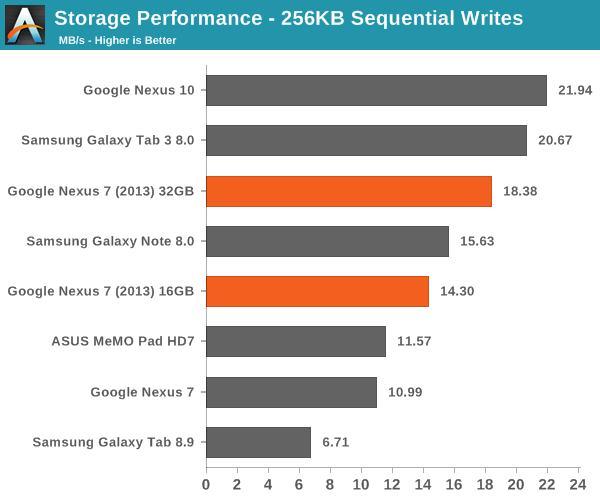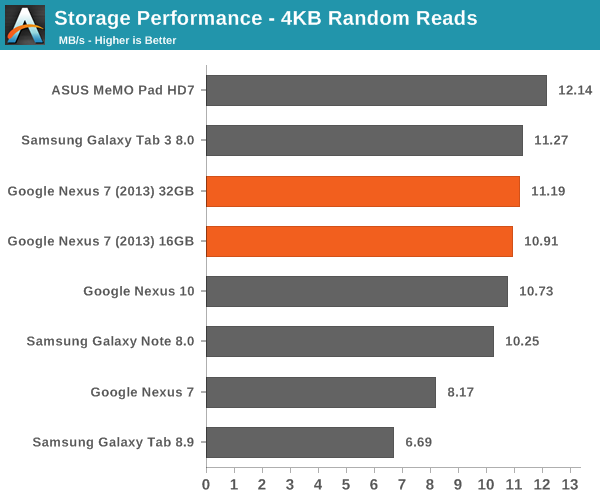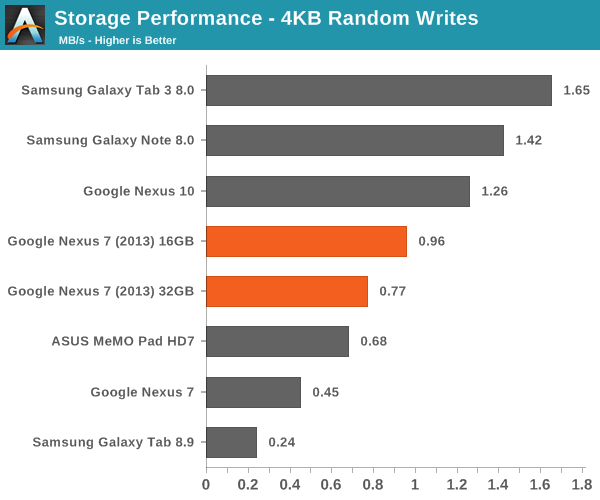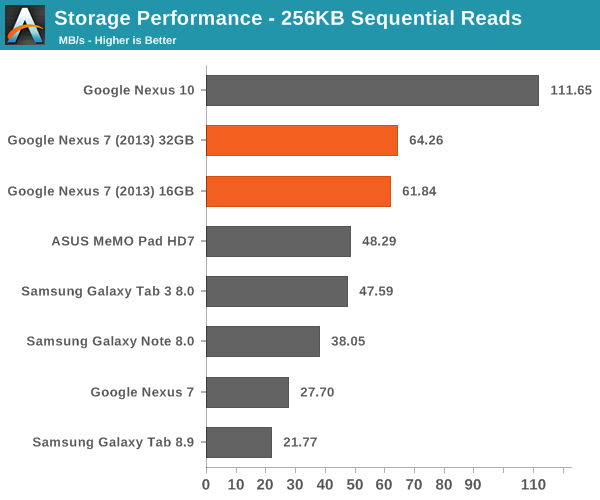The Nexus 7 (2013) Review
by Anand Lal Shimpi on August 22, 2013 6:00 PM ESTeMMC and FSTRIM
The new Nexus 7 obviously ships with the latest version of Android (4.3), which happens to add a major feature for keeping storage performance high: fstrim. Modern smartphones and tablets fundamentally use a very similar storage architecture to what we see in modern SSDs (solid state drives) in PCs. Instead of a drive featuring a discrete controller, DRAM and NAND flash, these ultra mobile devices typically feature one or two NAND devices with an integrated controller - typically eMMC. To keep costs (and power consumption) low there's also no DRAM cache, which definitely harms performance.
Since the underlying architectures are quite similar, the pitfalls are the same as well. The biggest issue? Performance when operating in a full or near-full state. With tons of files on your internal storage, the data structures that have to track all of those files and where they're located in NAND space get pretty complex, and traversing those structures takes a considerable amount of time. The part that many seem to forget is that once you delete a file in Android, it's not immediately removed from internal storage. The space is freed up in the OS, but the eMMC controller still tracks all of the data as valid bits. It's only when that data is overwritten that the controller knows the previous data didn't matter.
In other words, it's possible to have tons of free space on your internal storage, but have the drive appear full to the eMMC controller (and thus enjoy all of the terrible performance that goes along with it). To make matters worse, you never even have to fill your drive to get it into this state. In order to maintain even wear across all NAND cells (to extend the lifespan of the NAND flash), the eMMC controller will write to new/empty blocks in NAND as much as possible. Let's say you have 10GB of storage and Android writes 1GB of data to new addresses every month and deletes the previous 1GB each time. As long as the addresses being written to never overlap, your drive will be full in 10 months (from the eMMC controller's perspective) but Android will still report 9GB of free space.
fstrim establishes communication between the OS and the eMMC controller to address this problem - and it's enabled in Android 4.3.
Unlike TRIM on standard SSDs, FS_TRIM works more like the manual/scheduled TRIM tools from the early days of consumer SSDs. From Brian's original Android 4.3/TRIM article:
The Android framework will send out a “start idle maintenance window” event that the MountService listens for, and then invokes vold to fstrim filesystems when a few conditions have been met – the device hasn’t been touched for over an hour, no idle maintenance window event has been sent in 24 hours, and the device is either off-charger with 80% battery or on-charger with 30% battery. The goal is to have fstrim run roughly once every 24 hours if you’re in the habit of plugging the device in to charge every night.
Personally I feel like the rules are a bit excessive and I'd love to see us get to active TRIM on these devices, but I guess it's a bit too early for that. Basically if your device has enough charge and you're not using it, Android 4.3 will issue an fstrim command to the eMMC controller. The command passes along a list of all unallocated addresses in the filesystem, which the eMMC controller can then use to purge its logical to physical mapping table/list/datastructure. The process should complete relatively quickly as no new data has to be written, the controller just needs to do some cleanup of internal structures and add a bunch of addresses to the unused block pool. Keep in mind that this simply addresses the issue of your storage getting slower over time. fstrim does nothing to keep performance high if you actually fill your storage to capacity. Given how bad these eMMC solutions are, my recommendation is to try and keep at least 20% of your internal storage unused/as free space.
To showcase just how bad things can get I actually dusted off last year's Nexus 7 and treated it like an SSD. I first filled the device with sequential data, leaving only 300MB free. I then performed back to back random writes across the remaining free space and the performance reduction:
| Nexus 7 (2012) Storage Performance | ||||||
| Sequential Read | Sequential Write | Random Read | Random Write | |||
| New After Factory Reset | 25.18 MB/s | 10.63 MB/s | 7.08 MB/s | 0.45 MB/s | ||
| 1st Run After Fill | 22.25 MB/s | 1.21 MB/s | 7.62 MB/s | 0.14 MB/s | ||
| 2nd Run After Fill | 26.00 MB/s | 1.97 MB/s | 7.8 MB/s | 0.11 MB/s | ||
| 3rd Run After Fill | 24.57 MB/s | 3.18 MB/s | 7.96 MB/s | 0.16 MB/s | ||
| After ~24 hours Idle Time | 27.03 MB/s | 11.21 MB/s | 7.65 MB/s | 0.46 MB/s | ||
The columns to pay the most attention to are the write columns (read performance shouldn't change over time). Note that sequential write speed drops by almost an order of magnitude. This incredible drop in performance manifests itself as pauses or stutters. Even when you're just performing simple tasks on your tablet, there are usually tons of background operations going on (e.g. updating system logs). If you look at random write performance here, we see performance drop down to 0.11MB/s - or roughly 27 IO operations per second. If you have more than that amount of IO coming in at the same time, what you'll get are long pauses while the eMMC controller works through its IO queue. Although I didn't include it in the table above, I spent a full day torturing the eMMC on this Nexus 7 and managed to get random write performance as low as 0.02MB/s or 5 IOPS. Sequential write performance in that case was 0.81MB/s, equally disheartening. My point here is that worst case storage performance can get very bad, but looking at the last line of the table you see the incredible impact fstrim has on restoring performance.
I/fstrim ( 118): Starting fstrim work...
I/fstrim ( 118): Invoking FITRIM ioctl on /cache
I/fstrim ( 118): Trimmed 445079552 bytes on /cache
I/fstrim ( 118): Invoking FITRIM ioctl on /data
I/fstrim ( 118): Trimmed 13637656576 bytes on /data
I/fstrim ( 118): Finished fstrim work.
Anyone who had issues with their Nexus 7 slowing down over time will want to upgrade to Android 4.3. Those users considering upgrading to the new Nexus 7 should be fine thanks to fstrim. The only situation where you should see tremendous decrease in storage performance, resulting in IO latency enduced pausing/stuttering is if you physically fill the internal storage close to capacity. Again - my recommendation here is to try and leave at least 20% of your internal storage free. Note that this recommendation applies across Android and iOS.
With all of that out of the way, how does the eMMC solution in the new Nexus 7 stack up? Sequential read performance continues to be quite good for such a small/lower power device. Sequential write speed isn't terrible either. Even random read performance looks solid. It's random write performance that just needs work across the industry. We realistically need to probably be at 10x where we are today in random write performance, perhaps a bit lower if the storage makers can focus on IO consistency/minimum sustained IOPS.
Storage solutions in these tablets are often sourced from multiple vendors, and we can see dramatic differences in performance between them. Brian's review sample was a 32GB model, while the tablet I reviewed had 16GB. The two solutions performed pretty similarly, although my 16GB model did have appreciably better random write performance. Ultimately if you need the space, the 32GB model will be the better performer (you're better off using 45% of a 32GB model than 90% of a 16GB model).














202 Comments
View All Comments
eio - Friday, August 23, 2013 - link
After playing with the new Nexus 7, I seriously think that equip the same 7" screen with a ultra-thin border (like Optimus G2) would be the ultimate form factor of smartphones. It won't be as comfortable to carry as a 5" but the enlarged screen size are much more beneficial for a portable computing device, which what smartphones are nowadays (imo they are not "phone" anymore, everyone is looking instead of talking to them). I can carry a 7" device in my back pocket without much problem, daily.meloz - Friday, August 23, 2013 - link
I so wish this tablet had a 9-inch screen. Then it would be perfect for me. 7-inch tablets do not work for me because of text size; you cannot hold them down (at lap level when sitting in chair) with the the wrists resting on legs. You always have to raise them up like a smartphone to chest height, and that gets tiring if you are sat and reading a long document/file.I wish Asus and Google would make a 9 inch variant of this device. :(
cjs150 - Friday, August 23, 2013 - link
Do what I did. Get a Nook HD+ and root it back to standard android. Although I would also strongly recommend getting a matt screen cover because of the reflections.Works really well as an e-book reader
ShieTar - Friday, August 23, 2013 - link
I just imported myself a Cube U30GT. Its a 10", but surprisingly enough they managed to keep it to 320g, so its as comfortable to hold as most 7" tablets. I can definitely hold it comfortably with one hand while operating the screen with the other one.aniym - Friday, August 23, 2013 - link
Since when did 659g become 320g? Seriously, this spamming of Chinese tablets is getting tiresome? Do you really think that readers of Anandtech, of all sites, are going to fall for your BS?meloz - Friday, August 23, 2013 - link
ShieTar, does your "Cube U30GT" (never head of it before, strange) posses identical specs and performance as the Nexus 7?Somehow I doubt it. I am not interested in disposable Chinese junk.
ShieTar - Monday, August 26, 2013 - link
Nope, it does most certainly not have identical specs and performances. The CPU is admittedly on the slow side, and the hardware is the kind of plastic you expect from a 200$ tablet. I did not try to tell you that it is better in every aspect then the Nexus 7, I merely expected that your reason for wanting a 9" when there is already a ton of 10" devices would be weight, and I offered a comment on that topic.ASEdouardD - Saturday, August 24, 2013 - link
Yeah, it'S 670 g. Way more than 320. Also, I'd stay for away from cheap Chinese tablets for now. Tablets are computers. So many things can go wrong, I have to really trust the company I'm buying this from. I'm sure China (and hey, I don't consider Taiwan part of China) will get there soon and produce high quality tablets, but we're not there yet. Anyway all Android tablets are crap except the Nexus line anyway.ASEdouardD - Saturday, August 24, 2013 - link
To each his own. I feel 7 inch is the best size for me. I find even the iPad Mini too big to carry around a lot. The iPad 4 and the Nexus 10 are just way too big for that. They're more couch tablets then follow you everywhere tablets. I don't even realize I'm carrying around my new Nexus 7 in my man purse (it's European!) because it's so light and small.ASEdouardD - Saturday, August 24, 2013 - link
''than''. Sorry.